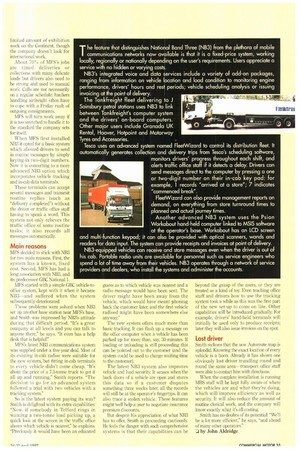TRACK RECOR
Page 34

Page 35

If you've noticed an error in this article please click here to report it so we can fix it.
Communication is of prime importance to Mixed Freight Services, based near Heathrow. It uses an advanced NB3 system which also enhances efficiency and security.
To the uninitiated, a modern traffic office can seem like organised chaos. Even with radio communication, simply receiving and transm itt i lig messages can be a full-time job for one or more staff. Conventional mobile phones or two-way radio systems are not cheap to run, but many messages are simply for confirmation or back-up.
Mixed Freight Services (MFS) believes it has found a more efficient communications system: National Band Three (NB3). This 26vehicle company is based near Heathrow Airport and specialises in air freight consignments. Most of its works is within a 200-mile radius, but as owner Alan Smith says: "We'll go wherever we're asked, if the price is right," The company has some 300 regular customers with jobs ranging from taking an envelope to nearby Langley to moving an aircraft engine to Lancaster, There's also a
limited amount of exhibition work on the Continent, though the company doesn't look for international work.
About 70".0 of MFS's jobs are timed deliveries or collections with many delicate loads but drivers also need to be strong and used to manual work. Calls are not necessarily on a regular schedule: hauliers handling airfreight often have to cope with a Friday rush of outgoing consignments. MFS will turn work away if it is too stretched to handle it to the standard the company sets for itself.
When MPS first installed NB3 it opted for a basic system which allowed drivers to send in routine messages by simply keying-in two-digit numbers. Now it is converting to a more advanced NB3 option which incorporates vehicle tracking and in-cab data terminals.
These terminals can accept several messages and transmit routine replies (such as "delivery completed") without the driver or traffic office staff having to speak a word. This system not only relieves the traffic office of some routine tasks: it also records all messages automatically.
Main reasons
MFS decided to stick with NB3 for two main reasons. First, the system has a known, fixed cost. Second, MI.'S has had a long association with N133, and its predecessor GI3C National 1.
MFS started with a simple GBC vehicle-tooffice system, kept with it when it became NB3--and suffered when the system subsequently deteriorated. Those problems were solved when NB3 set up another base station near MFS's base, and Smith was impressed by NB3's attitude during that difficult period. "It's a great company at all levels and you can talk to anyone there," he says. "It even has a help desk that is helpful!" MFS's latest N133 communications system was supplied under a five-year deal. Most of its existing in-cab radios were suitable for the new system, but fitting in-cab terminals to every vehicle didn't come cheap. "It's about the price of a 7.5-tonne truck to get it all up and running," Smith reports. "The decision to go for an advanced system followed a trial with two vehicles with a tracking system." So is the latest system paying its way? Smith is delighted with its extra capabilities: "Now. if somebody in Telford rings in wanting a two-tonne load picking up, a quick look at the screen in the traffic office shows which vehicle is nearest," he explains. "Previously it would have been an educated guess as to which vehicle was nearest and a radio message would have been sent. The driver might have been away from the vehicle, which would have meant phoning back the customer later, and the first vehicle radioed might have been somewhere else anyway' The new system offers much more than basic tracking. It can flash up a message on the office computer when a vehicle has been parked up for more than, say, 30 minutes. If loading or unloading is still proceeding this can be pointed out to the customer (and the system could he used to charge waiting time to the customer). The latest NR3 system also improves vehicle and load security. It senses when the back doors of a vehicle are open and stores this data so if a customer disputes something three weeks later, all the records will still be at the operator's fingertips. It can also trace a stolen vehicle. These features might well help a user to negotiate insurance Premium discounts.
But despite his appreciation of what NH3 has to offer, Smith is proceeding cautiously. He feels the danger with such comprehensive systems is that their capabilities can be beyond the grasp of the users, or they are treated as a kind of toy. Even teaching office staff and drivers how to use the tracking system took a while as this was the first part of the new set-up to come on line. Other capabilities will be introduced gradually For example, drivers' hand-held terminals will initially be used only to produce receipts: later they will also issue invoices on the spot.
Lost driver
Smith reckons that the new Autoroute map is splendid. Knowing the exact location of every vehicle is a boon. Already it has shown one obviously lost driver trundling round and round the same areatransport office staff were able to contact him with directions.
When the complete installation is running MRS staff will be kept fully aware of where the vehicles are and what they're doing, which will improve efficiency as well as security. It will also reduce the amount of routine clerical work, and the company will know exactly what it's all costing.
Smith has no doubts of its potential: "We'll be a lot more efficient," he says, "and ahead of many other operators."
:1 by John Aldridge




















































































































